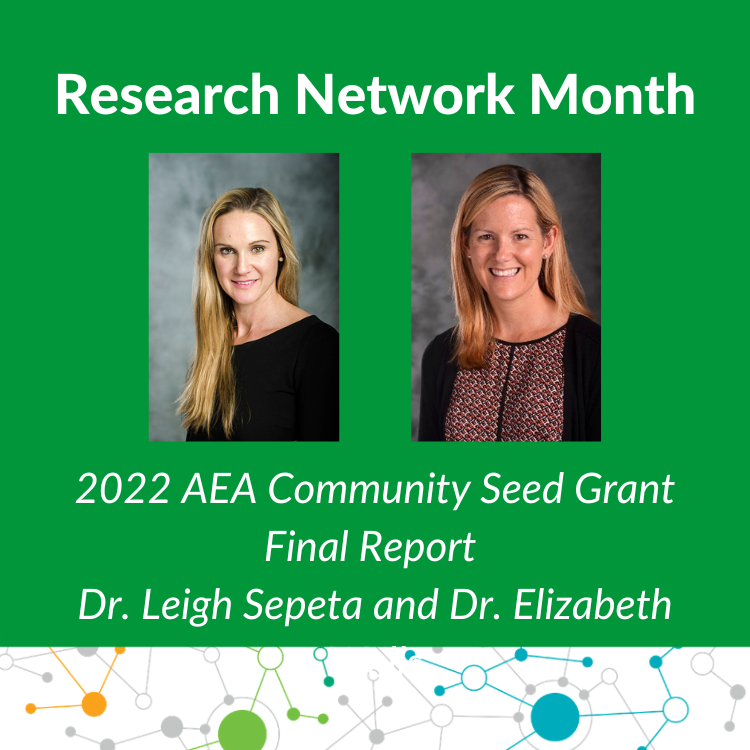2022 AEA Seed Grant Final Report: Dr. Leigh Sepeta & Dr. Elizabeth Wells
May 22, 2024

It was October 11, 2022 when we introduced Dr. Leigh Sepeta & Dr. Elizabeth Wells. Click here for their introductory post where we learned about them, their study plans and how their project would help patients and families affected by AE.
In the 2022 AEA Community Seed Grant Final Report, Dr. Leigh Sepeta explains the outcomes of the project, the Predictors of Cognitive Outcomes in Children with Anti-NMDA Receptor Encephalitis.
1. List the specific aims of your project and explain how they were met.
Our first aim was to establish clinical predictors of executive functioning and memory deficits in pediatric patients with NMDAR encephalitis. We examined predictors from commonly used clinical evaluations and metrics, such as use of second-line immunotherapy, length of hospital admission, and other disease-related factors at admission (e.g., mRS, EEG, MRI findings). Based on our preliminary data, we found that mRS at admission and duration of hospitalization predicted executive functioning. We are now adding data from six sites and looking at this with a larger patient population.
Our second aim was to determine neuronal biomarkers predictors of executive functioning and memory deficits in pediatric patients with NMDAR encephalitis. We assayed biomarkers of neuronal loss (tau, VILIP-1), synaptic dysfunction (neurogranin, SNAP-25), and inflammation (YKL-40) in NMDAR encephalitis using CSF obtained via spinal tap in patients at diagnosis (n=24) compared to pediatric controls (n=15) and adult controls (n=30). For this we collaborated with Gregory Day, MD, at Mayo Clinic and Jonathan Santoro, MD, at CHLA. We found that patients with NMDAR encephalitis had lower levels of biomarkers of synaptic dysfunction and higher levels of inflammation. We are currently seeing how this relates to outcome.
2. Describe the proposed impact/relevance of the project and the outcome.
Early, accurate prediction of cognitive deficits following NMDAR encephalitis is important for many aspects of patient care, including treatment and education planning, as well as family coping. Currently, parents and the medical team make decisions about school and treatment plans without knowing if a patient will be on a steep trajectory of cognitive recovery or if the patient will experience significant ongoing challenges in EF and memory. More is known about factors that predict cognition in adults; however, differences exist between children and adults in NMDAR encephalitis. Our approach is novel because although studies have utilized these biomarkers of neuronal loss and inflammation, to our knowledge, none have focused on a pediatric population or predicted EF and memory ability. This study is important to advance understanding of the neural basis of memory and EF development in the context of disease.
3. Explain how the results of your project have direct implications for patients with AE.
Autoimmune Encephalitis often affects previously healthy, typically developing children and sets families on an unexpected path of supporting a child with new challenges in learning and life. In particular, the memory difficulties and learning difficulties can require significant support in school and at home, and parents often ask their child’s doctors what to expect in the future. Children with autoimmune encephalitis do not necessarily follow the trajectory of brain injury and lasting damage seen in children with other brain diseases or injuries. Some children with autoimmune encephalitis have experienced remarkable recoveries through treatments, rehabilitation and learning support. Other children have had significant recovery in some domains of brain function but are left with lasting residual effects especially with memory, attention and planning. Families and doctors recognize that brain recovery in pediatrics is complex and there will always be a range of outcomes. Nevertheless, we hope that this research study will help identify new lab tests to predict better or worse neurocognitive function in children who have autoimmune encephalitis. The goal is to help families better understand the path ahead and aid doctors, therapists, teachers and parents in their work to achieve the best outcome for each child.
4. How did the AEA Community Seed Grant contribute to your ability to complete this project?
Without funding from the AEA, this research would not be possible. This funding specifically allowed us to collaborate with other programs.
Thank You, Thank You, Thank You!
Thank you, Dr. Leigh Sepeta & Dr. Elizabeth Wells for your research and your commitment to improving the lives of patients and families impacted by AE.
Thank you to the entire AE Alliance Community for contributing during the 2021 Research Network Month which assisted in funding this seed grant project.
Thank you for your contributions this year to fund future research!
Together, we are changing the course of AE.